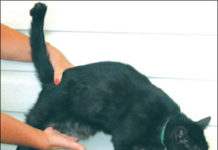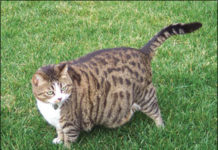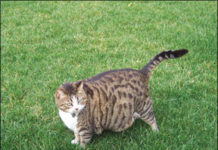Ask Elizabeth: 10/09
One of the main problems is ensuring that the diet is nutritionally balanced. Although it may appear that cats can live and even thrive scrounging for food on their own, a cats nutritional requirements are actually quite complex. When cats eat prey, they ingest the whole animal - and it can be hard to duplicate this "complete" diet with muscle meats and other foods obtained from a grocery store. It also takes a lot of time, expense and knowledge to prepare a well-balanced diet, and many published recipes for home cooked pet diets have been found to be nutritionally incomplete. Even when the diet is balanced, it needs to be prepared so that picky cats cant selectively eat only certain ingredients. Unbalanced Diets & Nutritional Diseases. The veterinary literature is full of documented cases linking improper diets to nutritional diseases, some of which are fatal. Well-meaning owners feeding all-meat diets have caused serious calcium deficiencies resulting in catastrophic bone fractures. While bones contain calcium, feeding cooked bones may cause intestinal blockages or perforations, leading to peritonitis (a potentially fatal infection in the abdomen). Large amounts of tuna fish can cause thiamine (vitamin B1) deficiencies, resulting in neurologic disease (tuna cat foods are supplemented with thiamine to prevent problems). Deficiencies of the amino acid, taurine, result in blindness and cardiomyopathy (a potentially fatal weakness of the heart muscle). Interestingly, while muscle meats contain large amounts of taurine, grinding the meat can reduce taurine levels enough to cause deficiencies.
Short Takes: 07/09
Legislation in California that seeks to mandate spay and neuter surgery for most cats and dogs has been placed on the suspense file pending further review. Senate Bill 250, introduced in February by Sen. Dean Florez, requires that dogs be spayed or neutered unless their owner gets an unaltered dog license. It also requires that roaming cats be spayed and neutered. The Senate Appropriations Committee analysis on SB 250 states that the bill has costs associated with it in the short term. As a result, it was placed on a list with other bills which have a fiscal impact on state and local governments. All bills placed on the suspense file are scheduled to be taken up together at a later date. Staff and lawmakers review all bills that are projected to cost more than $150,000, and then decide which bills will be released to the committee and voted on.
Bothersome Eating Behaviors
One cat knocks its food bowl over and makes a mess on your floor every time it eats. Another cat is a thief. It hops onto your kitchen counter at any opportunity to snatch whatever morsel of food it might spot lying there. A third cat spends a good part of its time gnawing on the clothing it finds in your closet. These are among the more common, puzzling, and often very annoying feline eating-related behaviors that, if not appropriately addressed, can seriously compromise the relationship between a cat and its owner. Some such unusual activities, says Katherine Houpt, VMD, James Law Professor of Behavioral Medicine at Cornell University's College of Veterinary Medicine, can signal the presence of a serious physical disorder and will thus merit the attention of a veterinary nutritionist. Others are merely goofy habits that the cat has picked up and can probably be rectified by an owner. And still other undesirable eating habits may stem from deeply rooted "neurotic" problems that can only be successfully reversed with the help of an animal behaviorist - sometimes with the help of certain feline anti-anxiety medications. When is it time to seek the advice and guidance of a behaviorist? "Certainly if the animals habits are seriously endangering the cat-human bond," says Dr. Houpt. "This is an especially urgent matter if the owner is thinking about abandoning a cat to a shelter or, even worse, having it euthanized. Likewise, an owner should seek behavioral consultation if the eating behavior - consuming indigestible materials, for example - could pose a physical threat to the animal."
Obesity: A Big Problem
Feline obesity is a problem among housecats. "As many as 30 to 40 percent of cats are overweight, with 15 to 20 percent falling in the obese range," says Joseph Wakshlag, DVM, PhD, DACVN, assistant professor of clinical nutrition at Cornell Universitys College of Veterinary Medicine. Despite public education efforts by the veterinary community, the numbers have not improved over the past decade, which is especially troubling because added weight can have serious health repercussions for cats. An overweight cat is at risk for several diseases, relates Dr. Wakshlag. "Obesity is one of the biggest factors for feline diabetes II," he says, adding that the extra weight carried by heavy cats causes stress on the felines joints, which can cause early onset of arthritis. Obese cats are also at heightened risk for feline hepatic lipidosis (FHL), or feline fatty liver syndrome, a liver disease that occurs when fat cells build up in the liver and prevent it from functioning normally. Heavy cats also may have more difficulties grooming themselves, which could cause hygiene and skin issues. Overweight cats may also be at increased risks in surgery.
Short Takes: 08/08
With 28.7 percent of all adult American cats classified as "overweight" and 6.4 percent as clinically obese, things only get worse with age. Among cats between five and 11 years of age, fully 44 percent are either overweight or obese. Just in time (we were about to have Frannie, the ShortTakes office kitty, fitted for running shoes) comes this report in the Journal of the American Veterinary Medical Association (Vol. 232, No. 11): "Nutraceuticals and dietary supplementation for the management of obese and overweight pets." The study looked at everything from omega-3 fatty acid supplementation, amylase inhibitors and DHEA (dehydroepiandrosterone) to L-carnitine, CLA (conjugated linoleic acid) and dietary phytoestrogens. Some, such as diacylglycerol, make a computers spell-checker burp. And not all, including the last one, have been tested on cats.
The Gluttonous Cat
You merely open your eyes in the morning - and your cat sprints to the kitchen. You head for the refrigerator and trip over the cat, who is winding around your legs, begging for food. Is the food gone as soon as it hits the bowl? Worse yet, does your cat wake you up in the middle of the night to be fed? Theres always a reason for excessive hunger in cats. Sometimes it signals underlying illness; sometimes its a matter of conditioning or boredom. Heres what you need to know about your ravenous cat. It seems obvious to say that a cat that is overweight is eating too much. "But it all depends on the cat," says Kathryn E. Michel, DVM, an associate professor of nutrition at the University of Pennsylvania. "Some cats can choice-feed. If you leave out food, theyll eat what they want and maintain a good weight. Other cats will eat everything you put out for them and then look for more."
What Is Cushing’s Disease?
Your cat Pinky has enjoyed good health for most of the eight years shes spent in your home. Lately, however, shes been undergoing some worrisome changes. Shes eating and drinking much more than she used to; shes recently begun to develop a potbelly; and shes become uncharacteristically lethargic. While such changes could be attributable at least in part to her advancing age, they are also signs that Pinky could be afflicted with a disorder called hyperadrenocorticism, otherwise known as Cushings disease. According to Deb Zoran, DVM, PhD, an associate professor of medicine at Texas A&M Universitys College of Veterinary Medicine and Biological Sciences, this condition is extremely rare in cats - far less frequently diagnosed than it is in dogs. Nevertheless, cat owners should be aware of Cushings disease, its causes, the clinical signs associated with it and the treatment options available.
Ask Elizabeth: 12/07
Dear Elizabeth, I read the column about your weight problem a few months ago; how is your diet going? Ive tried to follow your advice when feeding my own chubby cat, Ernie, but am having a tough time. I calculated his daily calorie requirement as you suggested and split that amount between breakfast and dinner. But since I work all day I leave him a little extra dry food in a bowl for lunch. Its always gone when I get home so he must get really hungry during the day. Then, after he gobbles up his dinner hes okay until much later when he really needs a small bedtime snack. I know that his total calorie intake each day is more than the formula says he needs, but hes so hungry! How have you managed your appetite?
Feeding Your Cat: How Many Meals Is Ideal?
Check the pet food aisle at your local supermarket, and youll find countless varieties of food to entice your cat. Feed your cat too little or the wrong kind of food, and he wont maintain good health. Feed him too much, and hell get fat. But you can help get your cat off on the right paw by establishing regular feeding routines. Although the food you feed your cat should be complete and balanced, the simple answer to how often you should feed him is that there isnt a simple answer.
Obesity: A Major Health Risk
For the first several years of her life, your cat Tina was slim, agile and remarkably athletic. In the past year or so, however, Tina, formerly light on her feet, has become heavy in her body. You can no longer see or feel her ribs. She seems to have accumulated a pad of fat over her spine, and it even appears that shes developing quite a potbelly.
Diet-Related Disorders
Fortunately, advances in research on feline nutrition have made todays cat foods safe and healthful. But there are still pitfalls.
Cats and Anorexia
This eating disorder is fairly uncommon in our four-legged friends, but they need immediate help.

















